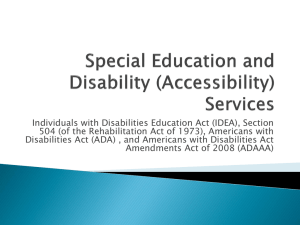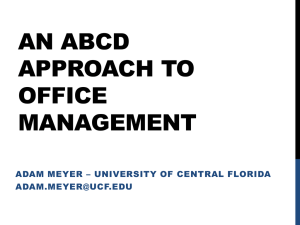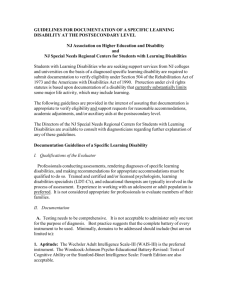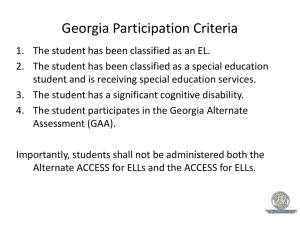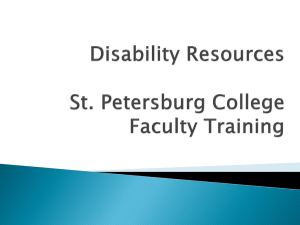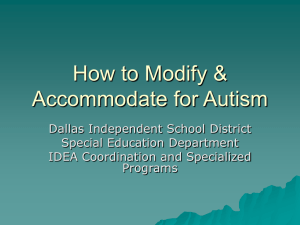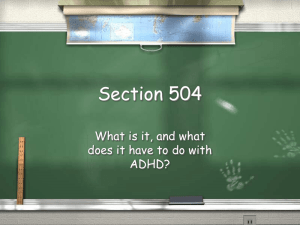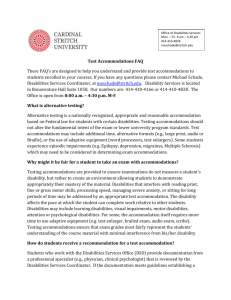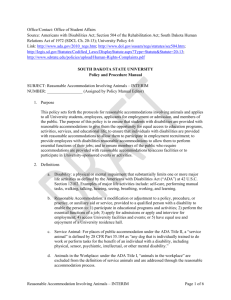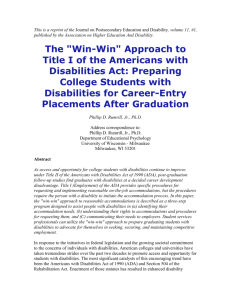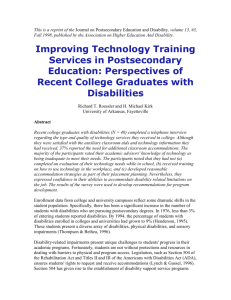Helping Post Secondary Students with Disabilities Believe They Can
advertisement
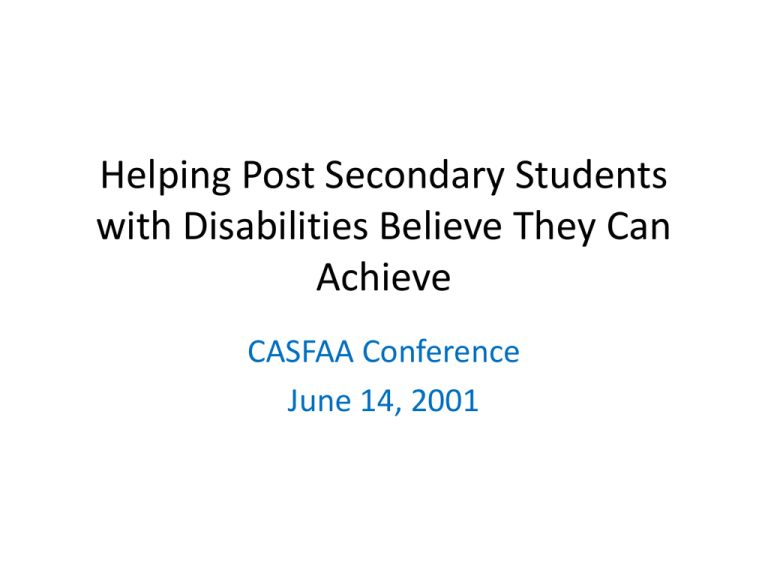
Helping Post Secondary Students with Disabilities Believe They Can Achieve CASFAA Conference June 14, 2001 Bonnie Blankert, M. Ed. Access Advisor, Mount Royal University President, CADSPPE (a Division of CACUSS) Overview 1. Intro to PSPSD Accommodation Guidelines 2. Universal Instructional Design 3. Functional Limitations and Academic Accommodation 4. How Access Advisors determine reasonable accommodation 5. Questions PSPSD Accommodation Guidelines (The Alberta) Postsecondary Service Providers for Students with Disabilities (PSPSD) guide to assist instructors and advisors who serve students with disabilities. https://www.cacuss.ca/en/divisions/CADSPPE/resources/ Accommodating_Students.htm Purpose of the guide The guide was developed to provide guidance to instructors and advisors who serve students with disabilities to address the impact of educational barriers in the postsecondary academic environment The guide lists: 1. Functional Impacts of Difference and Accommodations 2. Commonly named disabilities and accommodation options 3. It also describes accommodations and adaptive/assistive technologies What is disability? • The UN Convention on the Rights of Persons with Disabilities explains that “disability results from the interaction between persons with impairments and attitudinal and environmental barriers that hinders their full and effective participation in society on an equal basis with others” (Preamble) . http://www.un.org/disabilities/default.asp?id=259 Accessed November 12, 2010 Disability is an interaction between Person with impairment Barriers – environmental and attitudinal Disability does not “live” within the individual Examples of disabilities: • When a wheelchair user is unable to navigate a curb • When a person with a print disorder cannot read a textbook • When a Deaf person cannot access a lecture • When a person who has mental illness cannot recall what they have read People with impairments do not necessarily experience disability in all areas and therefore disability does not always exist! For example, • a person with a Reading Disability may not be disabled while playing hockey • a person who is Deaf and communicates through use of sign language will not be impaired when interacting with a group of people who sign How can we reduce the impact of disability in education? The path to removing barriers to learning is through: the use of principles of universal instructional design (UID) in conjunction with reasonable accommodations. What is Universal Instructional Design? • Universal Instructional Design (UID) is a process that involves considering the potential needs of all learners when designing and delivering instruction. • UID means identifying and eliminating unnecessary barriers to teaching and learning while maintaining academic rigor. • UID evolved from the concept of universal design in the physical world, where domains such as architecture and industrial design have identified key goals for their products, including flexibility, consistency, accessibility, clarity, and supportiveness. Examples of UID in architectural design Curb cuts Pedestrian ramps • UID applies the very same principles to teaching and learning. Examples of UID in education Hands on learning Photo essays Take home exams • UID is about truly universal thinking – it goes beyond just accessibility to reflecting on how to maximize learning for students of all backgrounds and learner preferences while minimizing the need for special accommodations. While universal instructional design will reduce and may ultimately eliminate barriers in education, accommodation is the current leading approach for ensuring that persons with disabilities have access to postsecondary education. What is Academic Accommodation? • Accommodation is the process of making alterations to the delivery of services so that those services become accessible to more people. • Accommodation is a shared responsibility of the institution and the learner. Accommodation includes but is not limited to: • the people who provide services (e.g., faculty) • Institutional policies related to matters such as admissions, attendance, course load, or graduation requirements • Campus facilities such as classrooms and laboratories • Equipment such as computers Why do we accommodate? Rights of persons with disabilities are enshrined in the: • UN Standard Rules on Equalization • Canadian Charter of Rights and Freedoms and • Alberta Human Rights Act Interpretive Bulletin: Duty to Accommodate Students with Disabilities in post-secondary institutions - 2005 Service providers must “not discriminate against any person or class of persons with respect to any goods, services accommodation, services or facilities that are customary available to the public”. Alberta Human Rights Commission (2005) Equity The goal of providing academic accommodations is to “level the playing field” for all students within the postsecondary environment. Functional Limitations • A functional limitation refers to the effect of the disability on access, learning, behaviour, or performance E.g., For those who are Deaf (impairment), perception of auditory information in the classroom (auditory lecture environment) is impacted and is the functional limitation. The interaction between the impairment and the environment lead to a functional limitation. • Reasonable academic accommodations must be linked to functional limitations. – A person with a learning disability would not receive the accommodation of a sign language interpreter. • Students with different impairments often share functional limitations – Students with ADHD, Mental Illness, or Aquired Brain Injury all may have attention regulation issues • Students with the same diagnosis may not necessarily share the same functional limitations, or experience them to the same degree. – Not all students with a reading disability may require screen readers for text books • Not all accommodations will be beneficial for all students with the same disability • Accommodations may also vary depending on the design and learning outcomes of individual courses and programs The Role of the Access Advisor • In consultation with students and based on the academic impact of documented disabilities, access advisors develop an Accommodations Agreement that outlines compatible accommodations for their programs of study, including field and practicum placements. Learner VS Enviroment • In an educational setting, variations in course design, delivery, evaluation and learner differences will determine the need for, and nature of, an accommodation. • The accommodations should be linked to the functional limitations or barriers the student is experiencing in the educational setting • Reasonable and appropriate accommodations are often creative solutions that develop from consultations with the student, the access advisor and the instructor. • Appropriate accommodations will meet the student’s particular needs and not contravene the integrity of the course/program objective, policy guidelines and professional ethics – Accommodated students must meet the same academic standards as other students – The student must develop the essential skills and competencies expected of all students • Particular attention must be given to analyzing the barriers of a practicum or field placement in relation to the bona fide educational requirements (those requirements that are a justifiable component of a program that may limit entry to, or completion of, a program or course) and the appropriate reasonable accommodations. • Licensing bodies for professionals, such as nurses, physicians, lawyers, pharmacists, and teachers; paraprofessionals, such as practical nurses and assistants; as well as, apprenticeship boards for the trades, will evaluate bona fide occupational requirements (those requirements that are justifiable components of an occupation or specific job). Samples from the PSPSD Guide ANXIOUSNESS AND STRESS While all students experience varying degrees of stress, some conditions elevate anxiety levels to the point of causing rapid heartbeat, profuse perspiration, physical illness, lightheadedness, fainting or panic attacks. As a result, one can be left emotionally and physically unable to perform common behaviors or tasks. Anxiety elevation may be triggered by different settings such as the classroom, labs, making presentations, or during exams. High levels of anxiety can affect one’s ability to think, recall information, concentrate, or pay attention. Accommodations to explore? • Reduced course load • Access to syllabus and textbooks before term begins • Advance Registration for classes • Note taker • Record lectures • Advanced notice of assignments, quizzes • Extensions for course requirements • Tutor • Alternate assignments for course requirements • Alternate format for print materials • Exam accommodations: extended time; low distraction environment; computer; breaks; limited number of exams per day; split exams; alternative question formats; rescheduling of exam times • Academic Strategist
